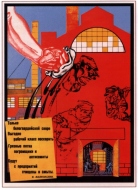Author: Rodchenko A. M.
Year: 1924
Dziga Vertov believed his concept of Cine-Eye, or "Kino Eye" would help contemporary man evolve from a flawed creature into a higher, more precise form. He compared man unfavorably to machines: “In the face of the machine we are ashamed of man’s inability to control himself, but what are we to do if we find the unerring ways of electricity more exciting than the disorderly haste of active people [...]” "I am an eye. I am a mechanical eye. I, a machine, I am showing you a world, the likes of which only I can see" Dziga was quoted as saying. Like other Russian filmmakers, he attempted to connect his ideas and techniques to the advancement of the aims of the Soviet Union. Whereas Sergei Eisenstein viewed his montage of attractions as a propaganda tool through which the film-viewing masses could be subjected to “emotional and psychological influence” and therefore able to perceive “the ideological aspect” of the films they were being shown, Vertov believed the Cine-Eye would influence the actual evolution of man, “from a bumbling citizen through the poetry of the machine to the perfect electric man.” Vertov believed film was too “romantic” and “theatricalised” due to the influence of literature, theater, and music, and that these psychological film-dramas “prevent man from being as precise as a stop watch and hamper his desire for kinship with the machine.” He desired to move away from “the pre-Revolutionary ‘fictional’ models” of filmmaking to one based on the rhythm of machines, seeking to “bring creative joy to all mechanical labour” and to “bring men closer to machines.” Original source of information from: http://en.wikipedia.org/wiki/Dziga_Vertov
Price: Free!















 2009 - 2026 All Rights Reserved
2009 - 2026 All Rights Reserved